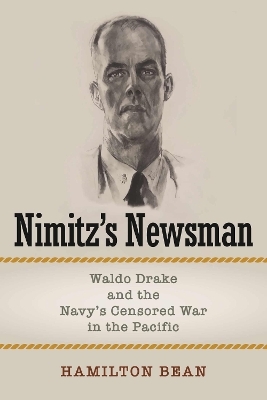
Nimitz's Newsman
Waldo Drake and the Navy's Censored War in the Pacific
Seiten
2024
Naval Institute Press (Verlag)
978-1-68247-793-9 (ISBN)
Naval Institute Press (Verlag)
978-1-68247-793-9 (ISBN)
In analysing the dynamics of Lt CDr Waldo Drake and Adm Chester Nimitz’s relationship, and in highlighting Drake’s interactions with correspondents and Navy officials, Nimitz’s Newsman reveals the inside story of the rise of the Navy’s public relations during World War II.
When Lt. Cdr. Waldo Drake, USNR arrived in Pearl Harbor in June 1941 as the U.S. Pacific Fleet’s first Public Relations Officer (PRO), he was an admired maritime reporter for the Los Angeles Times and Reserve Officer appointed to intelligence duties. By October 1944, he was hated by most of the correspondents assigned to cover the war against Japan and seen as by officials in Washington as an obstacle to the development of Navy public relations. What led Drake to become the Pacific Fleet’s first PRO, what happened during the three years he served on the CINCPAC staff, and why he was removed from that position are the focus of Nimitz’s Newsman: Waldo Drake and the Rise of U.S. Navy Public Relations.
Following the Japanese attack on Pearl Harbor on December 7, 1941, Adm. Chester Nimitz, USN assumed command of the Pacific Fleet and inherited Drake’s services. Drake became responsible for informing America’s press about the Pacific Fleet’s wartime role and thus gained an outsized ability to influence American public opinion. The Navy’s decision to allow public relations officers to censor press copy caused numerous conflicts between Drake and the correspondents assigned to the Fleet. It was Drake’s love for the Navy, his tendency to take on every job himself, and above all his close relationship with Adm. Nimitz that allowed him to perform censorship duties with approval. Drake’s protection of Nimitz, and his reticence to give the press any information that could endanger operational security or dampen morale, caused Navy victories to go under-reported—much to the consternation of officials in Washington.
In analyzing the dynamics of Drake and Nimitz’s relationship, and in highlighting Drake’s interactions with correspondents and Navy officials, Nimitz’s Newsman reveals the inside story of the rise of the Navy’s public relations during World War II.
When Lt. Cdr. Waldo Drake, USNR arrived in Pearl Harbor in June 1941 as the U.S. Pacific Fleet’s first Public Relations Officer (PRO), he was an admired maritime reporter for the Los Angeles Times and Reserve Officer appointed to intelligence duties. By October 1944, he was hated by most of the correspondents assigned to cover the war against Japan and seen as by officials in Washington as an obstacle to the development of Navy public relations. What led Drake to become the Pacific Fleet’s first PRO, what happened during the three years he served on the CINCPAC staff, and why he was removed from that position are the focus of Nimitz’s Newsman: Waldo Drake and the Rise of U.S. Navy Public Relations.
Following the Japanese attack on Pearl Harbor on December 7, 1941, Adm. Chester Nimitz, USN assumed command of the Pacific Fleet and inherited Drake’s services. Drake became responsible for informing America’s press about the Pacific Fleet’s wartime role and thus gained an outsized ability to influence American public opinion. The Navy’s decision to allow public relations officers to censor press copy caused numerous conflicts between Drake and the correspondents assigned to the Fleet. It was Drake’s love for the Navy, his tendency to take on every job himself, and above all his close relationship with Adm. Nimitz that allowed him to perform censorship duties with approval. Drake’s protection of Nimitz, and his reticence to give the press any information that could endanger operational security or dampen morale, caused Navy victories to go under-reported—much to the consternation of officials in Washington.
In analyzing the dynamics of Drake and Nimitz’s relationship, and in highlighting Drake’s interactions with correspondents and Navy officials, Nimitz’s Newsman reveals the inside story of the rise of the Navy’s public relations during World War II.
Hamilton Bean, PhD., MBA, APR, is professor in the Department of Communication at the University of Colorado Denver. He also serves as director of the University of Colorado Denver’s International Studies Program. He specializes in the study of communication and security. He has applied communication theory to the study of extremism, counterterrorism, disinformation, intelligence, public diplomacy, and resilience. He has earned multiple awards for scholarship from the National Communication Association and is a member of seven journal editorial boards.
| Erscheinungsdatum | 22.08.2024 |
|---|---|
| Zusatzinfo | 10 b&w photos |
| Verlagsort | Annopolis |
| Sprache | englisch |
| Maße | 152 x 229 mm |
| Themenwelt | Geschichte ► Allgemeine Geschichte ► 1918 bis 1945 |
| Geschichte ► Teilgebiete der Geschichte ► Militärgeschichte | |
| Sozialwissenschaften ► Politik / Verwaltung | |
| Wirtschaft ► Betriebswirtschaft / Management ► Marketing / Vertrieb | |
| ISBN-10 | 1-68247-793-2 / 1682477932 |
| ISBN-13 | 978-1-68247-793-9 / 9781682477939 |
| Zustand | Neuware |
| Haben Sie eine Frage zum Produkt? |
Mehr entdecken
aus dem Bereich
aus dem Bereich
ein Psychologe erlebt das Konzentrationslager
Buch | Hardcover (2024)
Kösel (Verlag)
22,00 €
Mythos „Stauffenberg-Attentat“ – wie der 20. Juli 1944 verklärt und …
Buch | Hardcover (2024)
Goldmann (Verlag)
24,00 €


